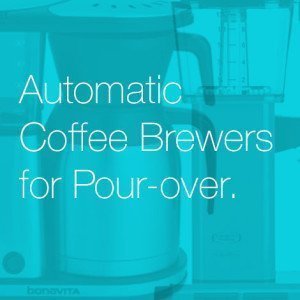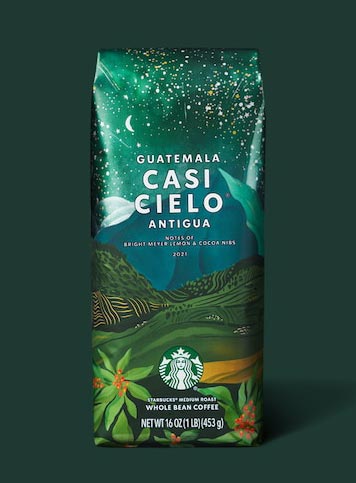Commentary
 Why should you bother with brewing pour-over coffee? Because it’s the best way to get the most of the good parts of the coffee. If you’ve never used the pour-over method, it may seem a little intimidating. But here you are with a 12oz bag of Hakimson Estate Kenya Peaberry Limited Release that set you back $19. Certainly you’re not going to toss that into a plastic coffee brewing machine. Pour-over coffee brewing is the method of choice for such a fine thing.
Why should you bother with brewing pour-over coffee? Because it’s the best way to get the most of the good parts of the coffee. If you’ve never used the pour-over method, it may seem a little intimidating. But here you are with a 12oz bag of Hakimson Estate Kenya Peaberry Limited Release that set you back $19. Certainly you’re not going to toss that into a plastic coffee brewing machine. Pour-over coffee brewing is the method of choice for such a fine thing.
Maybe you’ve watched a YouTube video on the subject where a barista was demonstrating his complicated pour-over coffee technique. Or maybe the idea of spending $30 on a Hario v60 cone dripper, another $45 on a gooseneck kettle, up to $130 on a burr coffee grinder, a $40 scale, yikes. It’s all a little much.
Pour-over coffee brewing is about simplicity
Brewing pour-over coffee may be trendy right now, but pour-over coffee brewing is really about simplicity, more than anything else. Just coffee and water to bring out the best in a well-sourced and craft-roasted bean.
I’ve been brewing pour-over coffee since the 80’s. I was not trying to being stuck-up about it; it was a necessity more than anything else. All I needed then was an affordable Melitta plastic drip brewer from the grocery store, paper filters, an inexpensive blade grinder and some good coffee beans and voila, cup of coffee! Back then Mr. Coffee, Brun or Krups were the main makers of coffee brewing machines: Mr. Coffee was considered a joke and Braun or Krups brewers were not cheap for the college student and later under-paid professional.
I had my share of machine brewers and French Presses*, but at some point they get stinky or the beaker would break, and i’d pull good ‘ol cone dripper out of the cupboard. Besides that, I liked brewing pour-over coffee. It was easy and convenient for a single cup. And I was never brewing for the crowd, so manually brewing pour-over coffee was not a hassle.
Pour-over coffee brewing became trendy
Fast forward to the mid 2000’s and suddenly Pour-over is the rage and touted as the method best to extract flavor from a well-sourced and craft-roasted bean. I’m not arguing with that at all, it happens to be my practice now. Being all artisan and precious about it is not the be-all end-all for brewing pour-over coffee.
Pour-over coffee brewing is simple because all you need is coffee, hot water, a paper filter in a cone dripper. That’s it. If you strive for better, splurge on some nice tools and refine your technique. You can brew great coffee with a $10 plastic Melitta cone coffee dripper you purchased from the local grocery store, DON’T LET ANY AFFICIONADO TELL YOU DIFFERENT (99% of whom will drink gas station swill in a fit of road trip desperation). So while the Melitta may not be the ultimate system, it is 90% of what you’ll get with a Hario v60, gooseneck kettle, water perfectly heated and a slow-poured over evenly sized coffee grounds, and light years better than a pot of coffee brewed in a Mr. Coffee machine.
Do it
Don’t worry about the hipster pour-over barista with the man-bun at your local to-cool-for-you cafe. Pour-over coffee brewing is the best way to get an amazing cup of joe. So go out and get a Melitta cone dripper, some filters, good beans, rush home and make a cup. It’s a great start, worry about the refinements later.
*I’ve tried to love French Press as my chosen method but I never could get past the residue at the bottom of the cup, too much like bong water for me, blech.
How to, Pour-over Coffee Brewing
Items needed:
- Goose-neck drip kettle
- Cone style coffee dripper
- Paper filters
- Digital kitchen scale
- Burr coffee grinder
- A cup or decanter
- Kitchen thermometer
- Heat the water
How to Brew Pour-over Coffee
Getting a great cup of coffee requires the right brewing equipment, fresh roasted coffee and a perfected pour-over coffee technique. This article is about how to brew pour-over coffee. Successful pour over coffee brewing is a mater of mastering a few steps. Fresh-roasted coffee, good filtered water, certain items for brewing: burr grinder, pour-over coffee dripper, paper or cloth filter, scale, gooseneck kettle, some people like to brew into a decanter, but straight into a cup works.
Start with the grind. You need an even grind to get good results, a good conical burr grinder will do this.
Heat water. Optimal temperature is 202º F or 65º C. But just off the boil if your boiling point is 212º is ok if you don’t have a thermometer. Heat water in a pot on the burner, transfer to a gooseneck kettle for the pour for control.
Slow pour. First bloom your grounds in the basket. No more than 80-100 grams at a time. After 1 minute or so after the grounds settle, start the main pour in increments of 80-100 grams at a time. Be sure to not add more water than coffee per the ratio. Don’t pour all the water at once, do it gradually.
Detailed instructions under the fold:
Bring the water to a boil then remove from the heating element. If you are using a temperature controlled electric kettle, just bring it up to a preset temp and hold. The optimal temperature is in the 198-201 degree range (depending on altitude, water will boil at a lower temperature).
Rinse the paper filter
Place the filter in the cone. Be sure to fold the seams over flat to make the filter sit better in the cone. Rinse your paper filter with the some of the heated water.
Grind and measure the coffee grounds
Weigh out the fresh beans to a 1:16 ratio, in grams, coffee to water. Experiment with ratios to suit taste. Grind to a medium-fine texture, the ground coffee grains should be about the size of sand. Note: A courser grind will cause the coffee to under-extract, resulting in a watery cup of coffee, too fine of a grind and the grounds will over-extract and taste bitter. Place your cup or decanter on the kitchen scale and zero (Tare) it. Add the coffee to the filter, level and slightly indent the center.
Zero the scale.
Bloom the coffee
Pre-infuse the coffee first. Pour 40-60g of hot water into the center of the grounds and work your way out, in expanding circles, until you reach the edge of the grounds. Some people recommend that you stop short of the edge leaving a 1/8 inch or so of the coffee dry. It probably doesn’t make a difference.
Let sit for 45-70 seconds. Note: the fresher the beans the more the grounds will expand as they release gases, older roasted coffee may not bloom at all. Let the bloom deflate before adding more water.
Start the main pour
After blooming, start the main pour, beginning from the center, pour the remaining water into the cone. Some like the do this in stages, pour, rest, pour, rest, etc. This should take around 2-3 minutes. Try to keep the water level above the coffee grounds, keeping oxygen from coming into contact with the coffee before you finish the pour. Take your time
Enjoy your cup!
Practice makes perfect! With good fresh coffee, proper equipment and technique you’ll be a pour-over master in no time.
Things to remember:
Grind
Measure
Bloom
Pour slowly
Watch this video and if you like please consider subscribing to our YouTube channel
Brewers, Drippers, Equipment, Online Shopping, Pour-over Coffee Brewing, Product Reviews, Shopping Guides

You know the situation; it’s a workday and you woke up late and now there’s not enough time to do a traditional pour over coffee, forget picking something up on the way to work, the lines are always too long! Wouldn’t it be nice to have an coffee brewer that made pour over coffee, and even better, automatically? Lo and behold! There are a few pour over coffee brewers available. They range in price from $180 to $570, and these brewers meet the SCAA Certified Home Brewer standards of the Specialty Coffee Association of America (SCAA). So you know you’re not wasting your money.
Why bother with a brewer that specializes in the pour over coffee method? Besides being the best way to brew coffee, pour over coffee brewers offer a simple hassle-free way to brew pour over coffee. Since they are automatic, you just set it at night and wake up to a fresh cup of pour over coffee. What could beat that? Other than a personal valet who makes pour over coffee for you, nothing obviously.
So check out our Pour Over Coffee Brewers buying guide.

Coffee Roasters, Fresh Roasted Beans, Starbucks
Guatemala Casi Cielo®/Whole Bean
Bright notes and floral aromas finishing in smooth cocoa flavor.
 If you’re looking for a good well-rounded
If you’re looking for a good well-rounded  everyday drinking coffee, Guatemala Casi Cielo is a good choice and right now it’s at Starbucks.com or Starbucks stores.
everyday drinking coffee, Guatemala Casi Cielo is a good choice and right now it’s at Starbucks.com or Starbucks stores.
Shop Now! Guatemala Casi Cielo®, Whole Bean
 Why should you bother with brewing pour-over coffee? Because it’s the best way to get the most of the good parts of the coffee. If you’ve never used the pour-over method, it may seem a little intimidating. But here you are with a 12oz bag of Hakimson Estate Kenya Peaberry Limited Release that set you back $19. Certainly you’re not going to toss that into a plastic coffee brewing machine. Pour-over coffee brewing is the method of choice for such a fine thing.
Why should you bother with brewing pour-over coffee? Because it’s the best way to get the most of the good parts of the coffee. If you’ve never used the pour-over method, it may seem a little intimidating. But here you are with a 12oz bag of Hakimson Estate Kenya Peaberry Limited Release that set you back $19. Certainly you’re not going to toss that into a plastic coffee brewing machine. Pour-over coffee brewing is the method of choice for such a fine thing.



